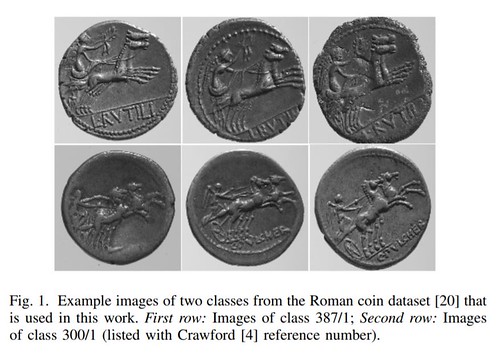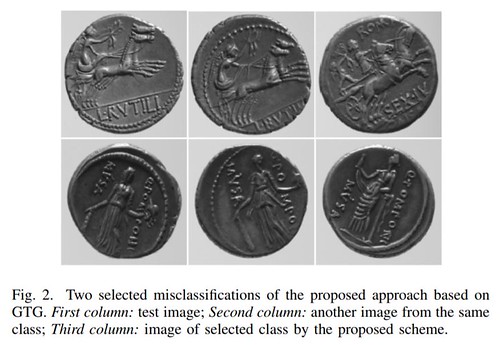
PREV ARTICLE
NEXT ARTICLE
FULL ISSUE
PREV FULL ISSUE
ANCIENT COIN CLASSIFICATION BY COMPUTERRobot coin cataloguer? How about a computer program that classifies ancient coin images by looking at them? Here's an excerpt from a new paper by a group of researchers in Italy and Turkey. -Editor Abstract  Specifically, we propose to model ancient coin image classification using Graph Transduction Games (GTG). GTG casts the classification problem as a non-cooperative game where the players (the coin images) decide their strategies (class labels) according to the choices made by the others, which results with a global consensus at the final labeling. Experiments are conducted on the only publicly available dataset which is composed of 180 images of 60 types of Roman coins. We demonstrate that our approach outperforms the literature work on the same dataset with the classification accuracy of 73.6% and 87.3% when there are one and two images per class in the training set, respectively. Ancient coins, that depict cultural, political and military events, natural phenomena, ideologies and portraits of god and emperors are important source of information for historians and archaeologists. Recognizing the type of an ancient coin requires theoretical expertise and years of experience in the field of numismatics. A common way to detect the period of a discovered coin is searching through the manual books where ancient coins are indexed which requires a highly time consuming labor. Our goal in this paper is automatizing recognition of Roman coins by employing computer vision and pattern recognition techniques. Automatizing such a manual procedure not only provides faster processing time but also can support historians and archaeologists for a more accurate decision. A visual classification framework for ancient coin recognition can also be used at museums or by individual collectors to organize large collections of coins. From the computer vision point of view, classification of ancient coin images is a highly challenging task. One of the difficulties arises from existence of high number of types (i.e. classes) in ancient coins (e.g. Portuguese coins from medieval period and coins from Roman Republic compose over 1500 and 550 different classes, respectively), while most of the classes include few known specimens as mentioned... Moreover, intra-class variation is large due to local spatial variations arising from missing parts and degradations on the coins, and manual manufacturing of coins by different engravers. Another reason of large intra-class variation is the metallic structure of these coins yields to strong reflection and shading variations so the appearance of the same coin changes significantly under different lighting conditions.  Yep - it's a hard problem, maybe impossibly so. Yet these techniques show promise, and with a large, high-quality, well-annotated image set, perhaps this could become a routine task for computers someday. This project used a very small dataset of just 180 images. -Editor To read the complete article, see:  Wayne Homren, Editor The Numismatic Bibliomania Society is a non-profit organization promoting numismatic literature. See our web site at coinbooks.org. To submit items for publication in The E-Sylum, write to the Editor at this address: whomren@gmail.com To subscribe go to: https://my.binhost.com/lists/listinfo/esylum All Rights Reserved. NBS Home Page Contact the NBS webmaster 
|